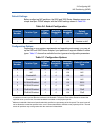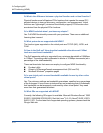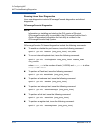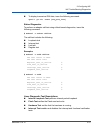
2–Configuring NIC
NIC Partitioning (NPAR)
SN0054671-00 B 2-71
Frequently Asked Questions about NPAR
NIC Partitioning
Q: What is NIC Partitioning (NPAR)?
NIC Partitioning (NPAR) is a method of dividing each QLogic Adapter Ethernet
port into a maximum of four partitions or virtual ports (eight virtual ports per
adapter). These virtual ports can be assigned NIC, FCoE, or iSCSI personalities,
and users can apply QoS settings by flexibly allocating minimum guaranteed
bandwidth to each virtual port.
Q: How is NPAR different from SR-IOV?
Single root I/O virtualization (SR-IOV) is an industry-developed specification that
identifies how a single PCI device can be partitioned and shared natively with
multiple OSs on the same physical host. NPAR is similar to SR-IOV in that both
allow partitioning a physical port into multiple partitions. With NPAR, the physical
port is partitioned into multiple physical PCIe functions. However, in the case of
SR-IOV, the physical port is partitioned into multiple virtual PCIe functions. This
difference in partitioning allows NPAR to be deployed in both bare metal
(non-virtualized) OSs and virtualized OSs. In contrast, SR-IOV is primarily
targeted towards virtualized platforms.
To deploy SR-IOV today, you will need to ensure a minimum level of infrastructure
(server hardware and OS) support for SR-IOV. Whereas NPAR is available today
with the 8200 and 3200 Series Adapters and supported with all major OSs,
including Windows and Linux, without any specific minimum server hardware or
OS support requirements, SR-IOV is not currently supported on Windows.
Q: How does NPAR allow me to use fewer adapters?
With NPAR, users can create up to eight virtual ports per QLogic Adapter. Each
virtual port can be a NIC, FCoE, or iSCSI port with minimum guaranteed
bandwidth. This means a single adapter can now replace multiple 1GbE NICs,
Fibre Channel Host Bus Adapters, and iSCSI Host Bus Adapters.
Q: How many MAC addresses are supported by my adapter?
Eight MAC addresses are supported in total—one for each physical function.
Q: What does “switch-agnostic” mean? What are the benefits?
Switch-agnostic means that the NPAR feature works when the 8200 and 3200
Series Adapters are connected to a 10GbE switch. This implementation gives you
broad interoperability in your environment and more freedom when choosing your
10GbE switch.


















